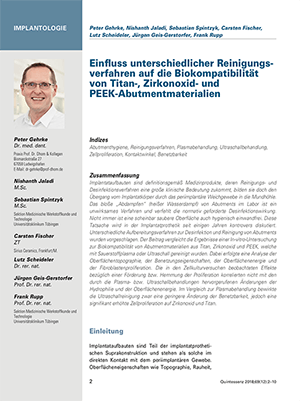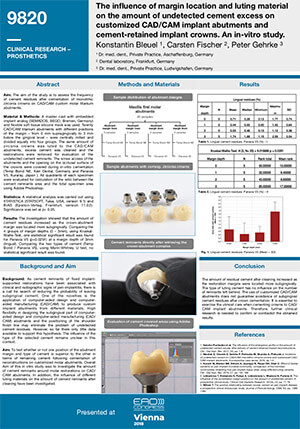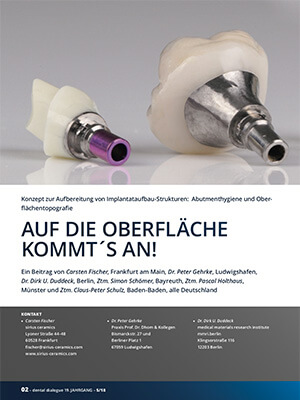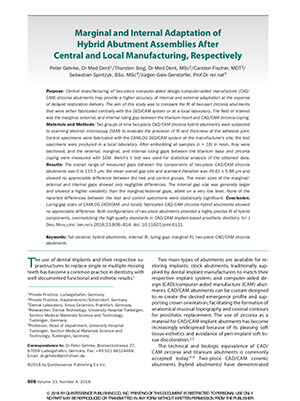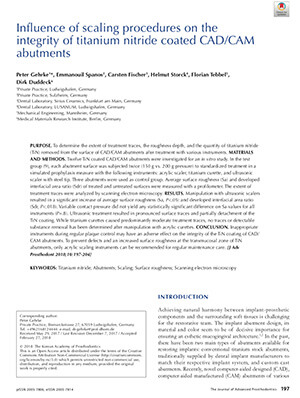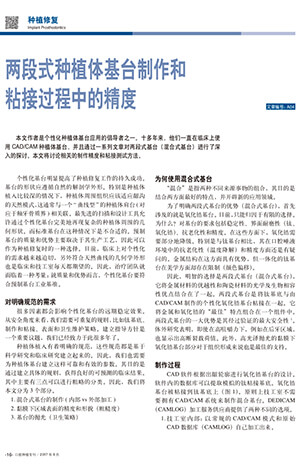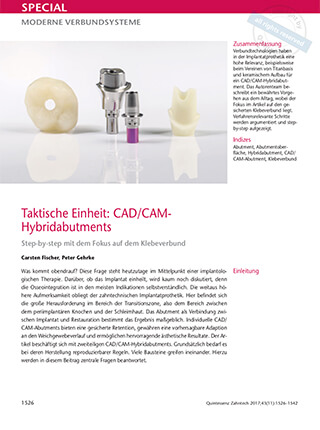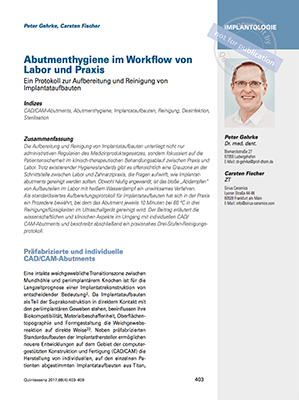Background:
As cement remnants of fixed implant-supported restorations have been associated with clinical and radiographic signs of peri- implantitis, there is a need for reducing the probability of leaving subgingival cement excess. High flexibility in designing the subgingival part of CAD CAM abutments and the individual positioning of the shoulder finish line may eliminate the problem of undetected cement residues. However, so far there is only little data available to support this hypothesis.
Aim/Hypothesis:
To test whether or not an epimucosal position of an abutment margin with temporary zinc oxide non-eugenol cement or methacrylate cement is superior to a submucosal margin position in terms of remaining cement following cementation of reconstructions on customized CAD CAM molar abutments.
Material and Methods: A total of 20 titanium CAD CAM abutments (Semados, BEGO, Bremen, Germany) with a convex emergence profile and different margin positions (from 0 to 1, 2, and 3 mm below the mucosa) were virtually designed and centrally manufactured. The master cast was scanned, duplicated by a 3D printer, and individual gingival masks were produced to simulate peri-implant soft tissues. 20 zirconia crowns (Zirlux, Henry Schein, Germany) were produced and cemented to the abutments with two different luting materials (Temp Bond NE, Kerr Dental, Germany, Panavia V5, Kuraray, Japan). To ensure retrievability of the crown abutment connection, occlusal openings providing access to the abutment screws were designed. Cement excess was thoroughly removed and the crown abutment units were unscrewed to evaluate the occurrence of cement residues. All quadrants of each specimen were evaluated for calculation of the ratio between the cement remnant area and the total specimen area using Adobe Photoshop (p 0.05).
Results:
Cement remnants were found in every depth of the crown abutment complex and in almost every area investigated. The amount of cement residues was influenced by the location of the crown-abutment margin. A significant increase in remnants was detected when the crown-abutment margin was located more submucosally. Deep crown–abutment margin positions (deeper than 1 mm below mucosa) increased the risk of cement excess. Oral and interdental areas are more prone to cement remnants than other surface areas. The investiga- tion showed, that cement remnants were not only found at the margins of the crown-abutment complex, but also underneath (basal) of the abutment itself, where literally no cleaning was possible at all. No statistical difference in the effect of a temporary zinc oxide non-eugenol cement (Temp Bond NE, Kerr Dental) and a methacrylate cement (Panavia V5, Kuraray, Japan) on the frequency of excess cement could be demonstrated.
Conclusions and Clinical Implications:
Given the results obtained in the present investigation the margin of CAD CAM molar abutments should be located as coronally as possible to minimize the amount of cement remnants. Due to esthetic reasons this ideal margin location is frequently not feasible. However, it cannot be recommended to place the margin of molar abutments deeper than 1.5 mm in the interdental and oral regions. There was no evidence that the type of cement had an influence on the amount of remnants after cleaning.
Weiterlesen

